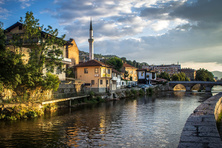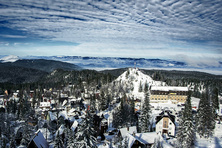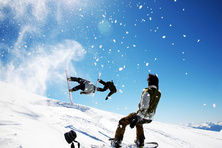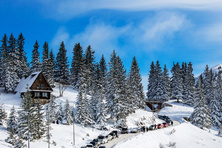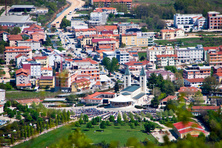Bosnia and Herzegovina
- Capital:Sarajevo
- Currency: convertible mark
- Time: UTC+1, summer UTC+2
- Languages: Bosnian, Serbian, Croatian
- Religions: Islam, Christianity
- Sections: Get in Visa Customs Cuisine Money Details of interest Popular resorts
Bosnia and Herzegovina is a European country in the central part of the Balkan Peninsula. It borders Croatia on the west and the north, Montenegro on the south-east, and Serbia on the east. The country has access to the Adriatic Sea. The capital of the country is Sarajevo.
The climate is temperate continental. Bosnia and Herzegovina has several microclimates which can be explained by its relief (almost 90% of the territory is highland). The tourists should be aware that the weather in the country can change several times during a day. The best period for visiting the country is from May to September.
There are three official languages in Bosnia and Herzegovina: Bosnian, Croatian and Serbian. A large part of the population (40%) confesses Islam, 31% of the people are the Christians and 15% are the Catholics.
The capital, the city of Sarajevo, will appeal to those who like walking along the streets and impress by its unique atmosphere. Narrow streets of the old town and a colorful Turkish market make the city particularly charming.
Make a trip to Bihać and an ancient town Mostar to enjoy ancient architecture and historical monuments.
Resort Banja Vrućica is popular not only among the locals but also among the foreign tourists who come to the country for a wellness tourism. If you like hiking, you will be impressed by the beauty of the local waterfalls.
Neum is an ideal place for a beach holiday.
Jahorina is an Olympic ski resort in Bosnia and Herzegovina. It works from October to May. Medjugorje is a popular site of Catholic pilgrimage. The travelers can see the place of alleged apparitions of the Virgin Mary to local children in 1981.
Get in
By Plane
You can go to Bosnia and Herzegovina by plane. The main airports receiving flights from CIS and EU countries are in Sarajevo and Tuzla.
By Land
You can enter the country from the territory of the neighboring countries by car, by bus or by train. There is no direct railway communication only with Serbia. Tourists from Serbia can go to Bosnia and Herzegovina by train with a stop in Croatia.
By Sea
There are no direct routes between Bosnia and Herzegovina and other countries. Tourists who like traveling by sea can reach Croatian port town Dubrovnik which is 20 minutes drive from Bosnia and Herzegovina.
Visa
The EU citizens who are planning to stay in Bosnia and Herzegovina less than 90 days do need a visa. The Ukrainians and the Russians do not need a visa, in case they stay in the country less than 30 days. The tourists from other CIS countries have to apply for a visa. They need to drop off the application documents personally (no later than 3 days before the expected date of entering the country).
Customs
You can import and export foreign currency in any amount but you must declare it. Export and import of the national currency is limited to 200 Bosnian marks (BAM). If the tourists bring more jewelry than it is allowed, they should declare it as well.
The tourists can import free of duty the following things:
- a small amount of alcohol and cigarettes;
- Perfume for a personal use;
- souvenirs for the total sum of 76 Euros;
- a small amount of jewelry for a personal use.
It is prohibited to import in the country:
- antiquities.
You cannot export from the country objects having artistic or historical value.
Cuisine
Food tours to Bosnia and Herzegovina will appeal to people who like the combination of Mediterranean, Slavic, Turkish, Persian and German cuisines. The locals brought a new twist to many traditional dishes of these countries.
You should begin your acquaintance with the national cuisine with the dish Bosanski Lonas (grilled meat and vegetables) or with Ćevapi (minced meat sausages).
Thick lamb soup Yagnetsa Čorba and fish soup Ryblya Čorba are local delicacies though these dishes came from Serbia.
From chicken they cook traditional chicken stew.
Fish and seafood are the main ingredients for various goulash, pies and salads.
You will be impressed by the great variety of desserts: lokum, halva, pies and donuts. Among the tourists, the most popular desserts are Alva (nuts in honey) and Štruklji (nuts and plums baked in cheese).
Coffee and herbal tee are the most popular soft drinks in Bosnia and Herzegovina.
Many guides believe that the tourists should not ignore the Bosnian wines. Of course, you should try national alcoholic drink Boza (malted drink made from maize), Salep (a drink made from the tubers of the orchid genus) and famous vodka Rakija.
Money
The national currency is Bosnian mark (BAM) which is equal to 100 feninga. The Central Bank of Bosnia and Herzegovina issues the bank notes from 10 to 200 marks. Euros are accepted almost everywhere in the country.
You can exchange foreign currency in exchange offices or at banks. Keep the recipes you receive as you will need them when leaving the country. We recommend you against unofficial exchange offices as there is a high risk to fall a victim to a fraud.
The cards Visa and Maestro are accepted in large malls, hotels and restaurants. If you plan to spend a lot of time in the country, be aware that there are not many ATMs beyond the capital of the country.
You can cash your traveler's checks only at banks and it will take you a lot of time.
Staying in Bosnia and Herzegovina, you should observe the safety measures. If you like to ride a bicycle in the country, never move away from the main road. The territory of the country is not completely free of mines after the latest war here. Avoid going to remote places at night.
Details of interest
Sightseeing in Bosnia and Herzegovina
In Bosnia and Herzegovina, there are two UNESCO sites:
- The Old Bridge (Stari Most) in Mostar. This foot bridge across the Neretva river was built in 1566. During the Croat-Bosniak War in 1993 the bridge was destroyed. It was completely restored with the assistance of UNESCO.
- The Mehmed Paša Sokolović Bridge of Višegrad across the Drina river. A trip to Višegrad will be interesting for those who like historical and architectural monuments and mountain trails. Not far from the town, there is a peak Varda.
In the country, there are several sites which are the World Heritage candidates:
- The city of Sarajevo. The travelers can walk across the Latin Bridge where Franz Ferdinand was killed and due to it the First World War began.
- Vjetrenica is the largest and the most important cave in Bosnia and Herzegovina.
- Jajce is a town located in a very picturesque place. It is an ideal place for walking and enjoying the mountains and waterfalls.
- Počitelj is the main local historical and architectural monument.
- Blagaj. A trip to this village allows the tourists see a tekija or a Dervish monastery.
- Blidinje Nature Park is the place for those who like mountain routes.
- Stolac. Here you will see the examples of rock painting in the Badanj cave, the ruins of ancient Greek settlements and the ancient cemetery.
- Stecaks. These are the medieval tombstones which are located all over the country.
Souvenirs from Bosnia and Herzegovina
Usually, the tourists bring from Bosnia and Herzegovina:
- things made of sheep wool;
- vodka Rakija;
- sweets;
- pottery;
- copper crafts decorated with silver.









